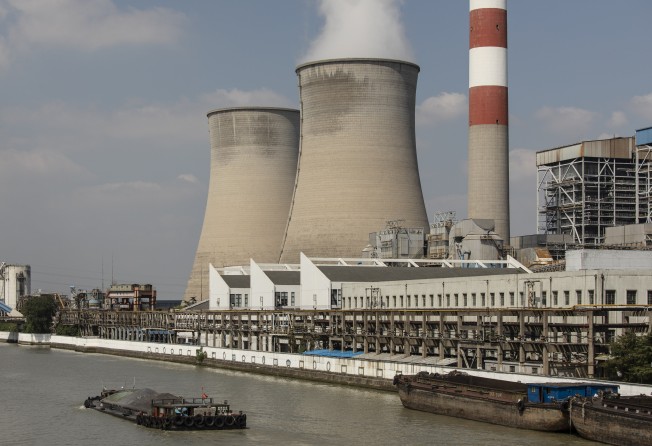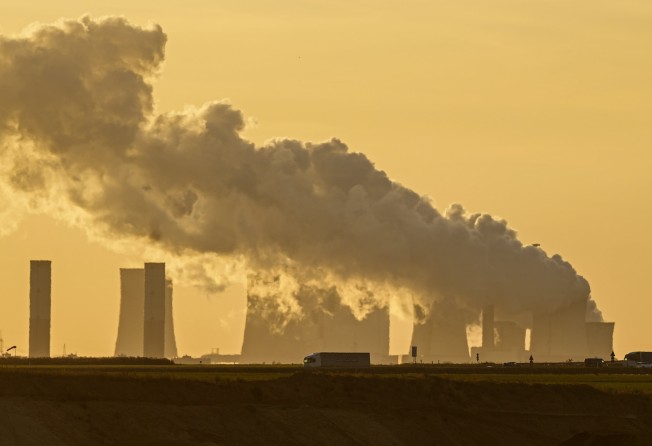China’s pledge to stop building overseas coal plants leaves Asian countries with more questions than answers
- President Xi Jinping’s pledge for China to stop funding overseas coal plants has cast doubt on the fate of nearly 70 coal-fired plants from Indonesia to Vietnam
- But while coal-reliant Southeast and South Asian countries grapple with how to meet growing energy demands, China’s move is a further nudge towards greener sources

When President Xi Jinping pledged at the United Nations General Assembly last month that China would no longer build new coal-fired power plants abroad, the announcement was hailed as a significant step amid increasing climate concerns. But it has also cast doubt on the fate of Chinese-funded coal plant projects already in the pipeline, and what it means for the power-supply plans of various countries.
According to data collected by This Week In Asia, nearly 70 coal-fired power plants across Southeast and South Asia that were in the planning stages are now at risk of being cancelled. Analysts say China’s moratorium will also effectively leave those regions without any new coal power plants, with the exception of India.
Compared to the rest of the world, the Asian region is generally still heavily reliant on coal, with the cheap but highly-pollutive fuel making up about 50 per cent of its energy mix.
In Southeast Asia, oil forms the largest element in the energy mix while coal has been the fastest growing, underpinning economic growth but also driving up emissions and affecting public health, according to the International Energy Agency’s 2019 report.
“The announcement is clearly a significant moment. With South Korea and Japan having shifted away from overseas coal finance, China was the last major public financier still considering coal projects in developing nations,” said Simon Nicholas, an analyst with the US-based Institute for Energy Economics and Financial Analysis (IEEFA).
“This promise brings forward the end of coal power development in such nations. The countries that were previously considering coal-fired power will see wind and solar ambitions increase. This process has already begun.”
China is the largest public financier of overseas coal plants. The Export-Import Bank of China and the China Development Bank accounted for 50 per cent of global public commitments to overseas coal-fired power plants for which funding was actually provided between 2013 and 2018, according to the Global Development Policy Centre at Boston University.
While China and India are the heaviest users of coal in Asia, coal-fired plants also make up a significant proportion of the power generation infrastructure in the Philippines, Bangladesh, Pakistan, Indonesia and Vietnam. These countries have signalled their determination at various levels to phase out coal, turning down new projects and instead seeking to expand renewable power generation amid the falling costs of new technologies.
The global pipeline of proposed coal power plants has collapsed by 76 per cent since the Paris Agreement in 2015, according to European climate change think tank E3G. The Japanese and South Korean governments also promised earlier this year to end new public financing for coal projects abroad.
“To the practitioners in the power industry, [Xi’s] pledge came as an emotional surprise. Some anticipated the government would rescue the industry in some ways to ensure employment. But industry wide, the demise of coal has long been anticipated,” said Changsu, the pen-name for a Beijing-based researcher who focuses on overseas power markets and previously worked at the international department of a Chinese state-owned electricity enterprise.
“Since one or two years ago, the banks have internally stopped considering financing overseas coal power projects, without making any public announcement. The power giants have all shifted their focus to clean energy. Many employees of the coal power industry switched to another industry or have planned to do so.”
While China’s ambitious Belt and Road Initiative, launched in 2013 to boost trade through the financing of energy and infrastructure projects once had a strong emphasis on coal projects, community opposition against dirty fuels in host countries has grown.
Christoph Nedopil Wang, director of the Green Finance and Development Centre at the Fudan University Fanhai International School of Finance in China, said since last year, China had not announced any funding for new coal-fired power plants overseas.
“In the first half of 2021, no Chinese financing has been provided for any coal-related activities in the Belt and Road countries,” he said.
Research published earlier by Wang – formerly the director of the International Institute of Green Finance at the Central University of Finance and Economics – found that energy and transport accounted for 65 per cent of all BRI investment in the first half of this year. Within the energy sector, more than half went to cleaner energy sources such as gas and hydropower.
Last year, Chinese overseas investments in solar, wind and hydropower exceeded investments in fossil fuels for the first time since the BRI was launched in 2013, according to Wang’s research.
While shifting away from coal might take some initial adjustments, China’s decision would not be lamented in the long-run because Asian countries were also cottoning on to the importance of using cleaner energy, observers said.
Swift reaction
Although Xi’s pledge was a single sentence and its details have not been announced, Chinese companies and financiers have quickly responded.
Several hours after his speech, Tsingshan Holding Group – one of the world’s largest stainless-steel producers, which operates a mammoth industrial estate in Morowali, Indonesia – announced on its WeChat account for subscribers that it would no longer build new coal-fired power plants at its overseas investment projects, and would instead proactively use green and clean energies such as hydro, solar, and wind. The privately owned steel giant also runs manufacturing hubs in India, Zimbabwe, and the United States.
The low cost of electricity, generated by the company’s self-built coal-fired power plants in the Morowali estate, had helped make its operations there competitive, analysts said. The company did not respond to a request for comment as of press time.
Two days after Xi’s announcement, Bank of China, one of the country’s four largest state-owned commercial banks, said from October 1 it would no longer provide financing for new coal power plants or coal-mining projects outside China.
While these developments drew attention, they show just a fraction of the impact his promise had on the international power industry. As many upcoming projects were at the negotiation stage, firms dropped out without issuing any public statements.

“Several large coal-fired power projects in the pipeline have been immediately impacted. Chinese enterprises took part in these projects as EPC or EPC-F [engineering, procurement, construction, and financing] contractors-to-be,” said Changsu, referring to projects in Vietnam and Indonesia.
“One enterprise was just two months away from signing a contract with the Vietnamese government, but it has decided to drop out. Some enterprises have signed BOT [build-operate-transfer] or joint-development contracts, while others have even signed financing agreements but are now considering whether to implement them. The projects are all in trouble.”
Xizhou Zhou, vice-president of global power and renewables at IHS Markit, said Chinese money for international coal projects around the world came mostly from state-owned banks such as China Development Bank and the Export-Import Bank of China – and “if Xi said something, private banks would not want to challenge that”.
“Financing is the key to the feasibility of a coal-fired power project,” Changsu said. “The banks in the host countries generally lack the capital to finance coal power projects. As long as the financing is cut off, no company, state-owned or private, will be able to invest or construct a project.”
However, Wang of Fudan University said the statements from Xi and local governments, taken together, now paved the way for a multi-billion dollar market for renewable energy investments from China, offering “great opportunities in employment, clean energy and affordable energy” overseas.
Absence of details
During his speech at the UN, Xi’s pledged: “China will step up support for other developing countries in developing green and low-carbon energy, and will not build new coal-fired power projects abroad.”
In the absence of further guidelines, observers and analysts have parsed his words for meaning, while calling for clarity on the operational impact and timeline for his pledge to be implemented.
“Are financing, design, and export of equipment all counted as ‘build’? Is a project that is about to break ground counted as a new one? Is a project whose materials have not been shipped from China counted as a new one? These are questions raised not only by environmental groups in countries with heavy Chinese coal investment but also by the Chinese energy industry,” said Xiaojun Wang, the executive director of Manila-based NGO People of Asia for Climate Solutions.
Nguyen Thi Hang, a programme manager at the Green Innovation and Development Centre (GreenID) in Vietnam, said the group hoped the pledge would be implemented right away. “The pledge is not clear. When will it take effect? Will it apply to all types of coal projects?” she said.
Pius Ginting, executive coordinator of the Association of People’s Emancipation and Ecological Action (AEER), an Indonesian environmental NGO, pointed to the significant role of Chinese capital in the development of mine-mouth power plants on the island of Sumatra.
The use of local, low-quality lignite coal on the island was made possible largely due to funds from Chinese financial institutes and investments from Chinese state-owned power companies, according to AEER’s research.
“The use of the low-quality coal in a region rich in clean energy resources increases greenhouse gas emissions and is not in line with the Indonesian government’s commitment to the Paris Agreement,” he said. “It is good news that the Bank of China has announced it will not finance new coal power and mining projects. The other Chinese banks and companies should follow suit.”

Alternative issues
Countries worldwide are grappling with the transition to cleaner energy, as major producers of fossil fuels reduce their output under pressure from environmental advocates and investors. But as the recent power crunch has shown, a mix of high demand for energy on the back of an economic rebound from the pandemic, shortages of power supplies, and unpredictable output from renewable sources can fuel volatility in the energy system.
In developing Asian countries where renewable energy infrastructure is lagging behind other regions, there are worries that shifting away from fossil fuels too quickly would compromise economic growth, spark inflation in energy prices and worsen inequality. Yet, in general the governments and people are also keenly aware of the environmental costs of inaction.
Zhou of IHS Markit noted that the demand for a reliable supply of energy for manufacturing industries was understated, and alternatives to current energy sources – such as battery-storage technology – were not yet mature enough to be deployed at a scale to back up wind and solar.
“We estimate that if solar and battery storage were used to meet all of the incremental demand over the next decade, it would require 70-130 gigawatts of batteries. In contrast, the whole world installed about 5GW of battery storage capacity in 2020, the highest year on record,” he said. “Battery storage will be much more mature, scalable and much cheaper, but the future may be five to 10 years away from now.”
Many countries see gas as a potential “transition fuel”, but Zhou noted that the alternative faces challenges such as high costs, a long lead time for liquid natural gas infrastructure and uncertainty over the role of gas in a net-zero-emissions world.
Changsu noted that as more solar and wind capacity is added to regional power systems, pumped-storage hydroelectricity would be an increasingly favourable option to abate the fluctuating output of intermittent energy sources.
Analysts and members of civil society organisations also note that proper financing is needed to bring about the transformation of power systems, and countries will need significant support to develop clean energy projects and enhance the adaptability of power systems.
Nguyen Hang of GreenID also pointed to the need for high-quality investment. “People [in Vietnam] have concerns over the quality of the technology from China. For example, people are concerned about how long solar panels will last and whether the panels will cause environmental problems after they expire,” she said.
But Sara Jane Ahmed, a finance adviser to the Vulnerable Group of Twenty (V20) ministers of finance of the Climate Vulnerable Forum (CVF), said Xi’s pledge offered clarity in safeguarding climate goals ahead of the upcoming UN Climate Change Conference, which is scheduled to take place from October 31 to November 12.
“It is important to complement the pledges made by China as well as the host countries toward the transition,” she said. “It is high time for other countries like the US and Australia to do their part, too, [in stopping] their funding of the expansion of gas production overseas.”
